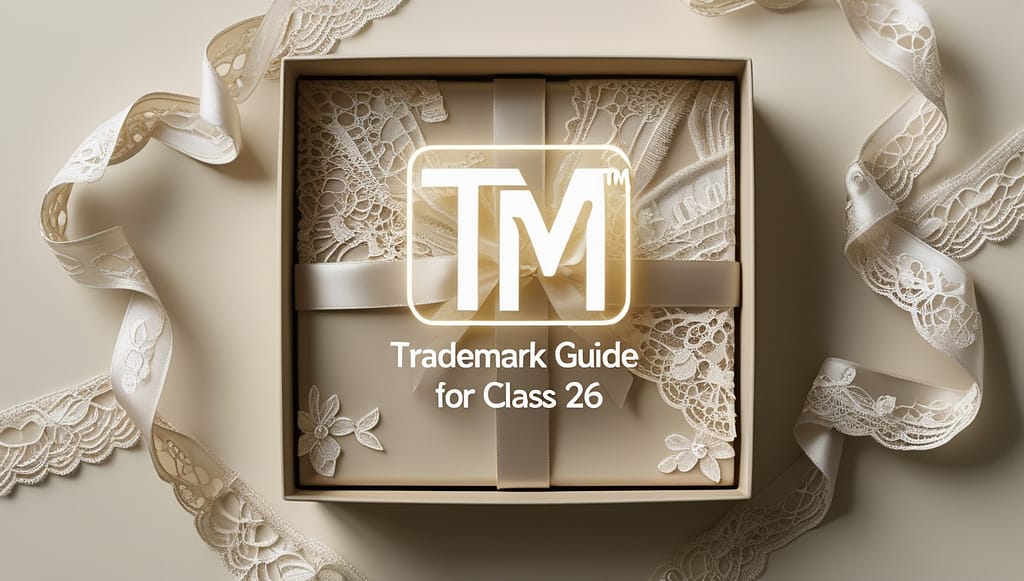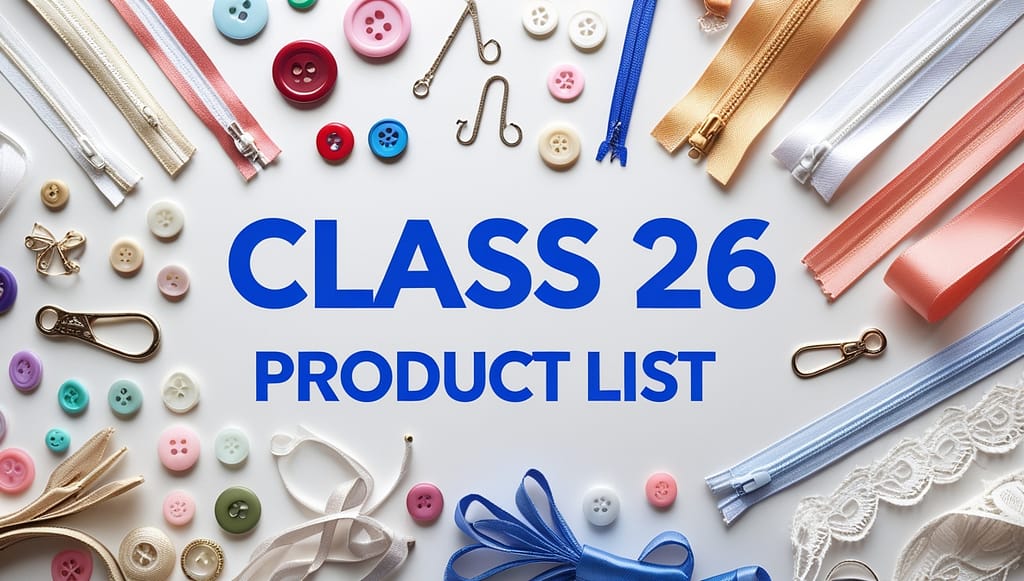How to Trademark Your Lace and Ribbon Brand in Class 26: Step-by-Step Guide
If you are in the business of manufacturing or selling lace, ribbons, or other decorative trimmings, protecting your brand identity is crucial. With thousands of small and large businesses competing in the textile and fashion accessories market, it’s easy for others to copy your designs, brand name, or packaging. This is where Trademark Class 26 comes in.
In this blog, we’ll explain how to trademark your lace and ribbon brand in Class 26, why it’s important, the step-by-step filing process, and common mistakes to avoid.

🔎 Understanding Trademark Class 26
The trademark classification system (Nice Classification – NCL) divides goods and services into 45 classes. Trademark Class 26 specifically covers:
- Lace
- Ribbons
- Embroidery
- Braid and trimmings
- Buttons, hooks, pins, and similar accessories
For lace and ribbon businesses, this class is the right choice because it ensures your brand name, logo, or unique designs are legally protected against competitors.
🎀 Why Do Lace and Ribbon Brands Need a Trademark?
The lace and ribbon industry is highly competitive. Many businesses supply to:
- Fashion houses
- Tailors and boutiques
- Packaging and gift industries
- Event decorators
- DIY craft brands
Without a registered trademark:
- Competitors can use similar names/logos to confuse customers.
- Fake or low-quality duplicates can damage your brand’s reputation.
- You may lose business opportunities with designers and exporters who prefer registered brands.
👉 A registered trademark helps you build credibility, protect your reputation, and expand globally.
📋 Products Under Class 26 for Lace and Ribbon Brands
Here’s what specifically applies to lace and ribbon businesses in Class 26:
- Lace (cotton, silk, synthetic, machine-made, hand-made)
- Ribbons (satin, velvet, grosgrain, polyester, decorative)
- Braids and ornamental trimmings
- Passementerie (fancy borders with tassels/fringe)
- Embroidered patches or appliqués
If your business also sells related products like buttons, zippers, or hair accessories, you can cover them under Class 26 too.
📝 Step-by-Step Guide to Trademarking Your Lace and Ribbon Brand in Class 26
Now let’s break down the filing process in simple steps:
1. Trademark Search
Before filing, check if a similar brand name or logo already exists in Class 26.
- Use the IP India Public Search Tool.
- Look for both exact and phonetically similar names.
- If something close exists, tweak your name/logo to avoid objections.
✅ Example: If your brand is “Ribbon Luxe,” and “Ribbona Lux” already exists, you may face opposition.
2. Choose a Strong Trademark
A strong trademark is unique and memorable. Avoid:
- Generic terms (like “Best Ribbons” or “Quality Lace”)
- Descriptive names (“Silk Ribbon Co.”)
Instead, use:
- Invented/fancy names (e.g., “Lacoria,” “Velorib”)
- Distinct logos or stylized fonts
- Combination marks (name + logo)
3. Prepare the Application
Your application must include:
- Applicant details (individual/company/partnership)
- Brand name/logo design
- Class of goods (Class 26)
- Specific description, e.g., “cotton lace, satin ribbons, decorative trims”
- Power of Attorney (if filed through an agent)
4. File the Trademark Application
- File online through the IP India portal or offline at the Trademark Registry office.
- Pay the government fee:
- ₹4,500 (individual/startup/small enterprise)
- ₹9,000 (other entities)
Once filed, you’ll receive an Application Number for tracking.
5. Examination of the Application
The Trademark Registry examines your application:
- If everything is fine → Accepted.
- If there are issues (similar marks, wrong description) → You’ll receive an Examination Report.
👉 You must reply within 30 days to avoid rejection.
6. Publication in the Trademark Journal
If accepted, your mark is published in the Trademark Journal for 4 months.
- If no one opposes → It moves to registration.
- If opposed → You must defend your mark legally.
7. Trademark Registration Certificate
Once cleared, you’ll get the Trademark Registration Certificate, valid for 10 years.
- Renewable every 10 years by paying the renewal fee.
💡 Example: How a Ribbon Brand Uses Class 26
Imagine you own a brand “Silkrib Creations”, which sells premium satin ribbons.
- You file a trademark in Class 26 for “decorative satin ribbons, lace, and trimmings.”
- Once registered, no one else can sell ribbons under the name “Silkrib” or use a confusingly similar logo.
- If someone tries, you can take legal action against them.
🚀 Benefits of Trademarking a Lace and Ribbon Brand
- Exclusive Rights – No one else can use your brand name in Class 26.
- Customer Trust – Adds credibility, especially with designers and exporters.
- Protection from Counterfeits – Stop cheap imitations from ruining your brand.
- Licensing Opportunities – You can license your brand to other sellers for royalties.
- Global Recognition – Trademarks help expand internationally under the Madrid Protocol.
⚖️ Common Mistakes to Avoid
- Filing under the wrong class (like Class 24 for textiles instead of Class 26).
- Using weak, descriptive names.
- Not responding to Examination Reports on time.
- Ignoring opposition notices in the Trademark Journal.
- Forgetting to renew after 10 years.
📊 Case Study: YKK – The Zipper & Fastener Giant
Although primarily known for zippers, YKK also produces trimmings and fasteners that fall under Class 26. By trademarking globally, YKK ensured that its name became synonymous with quality fasteners, preventing copycats worldwide.
Similarly, lace and ribbon brands can grow into global suppliers by protecting their identity early.
✅ Pro Tips for Lace & Ribbon Startups
- File Early – Don’t wait until your brand gets popular; protect it before competitors copy.
- Use Distinct Branding – A creative name/logo is harder to copy.
- Register in Multiple Classes – If you also sell fabrics (Class 24) or finished clothing (Class 25), apply in those too.
- Hire Experts – Professional help ensures smooth filing and reduces rejection chances.
📝 Final Thoughts
For lace and ribbon businesses, Trademark Class 26 is the right category to secure brand protection. From satin ribbons to embroidered lace trims, a registered trademark ensures your products stand out in the crowded marketplace.
Whether you’re a small startup selling handmade ribbons or a large lace manufacturing company, filing your trademark will safeguard your identity, build trust, and open doors for growth.
📢 About VMK Professionals
At VMK Professionals, we help businesses like yours file trademarks in the right class with ease. Whether you’re protecting lace, ribbons, embroidery, or other Class 26 accessories, our experts guide you through the entire process—search, filing, examination, and registration.
👉 Contact VMK Professionals today and secure your lace and ribbon brand before competitors do.



